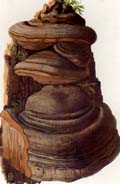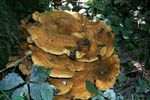 Key to Gilled Mushrooms Key
Key to Gilled Mushrooms KeyThis is a key to gilled mushrooms, that is, mushrooms having a definite cap with a fertile surface consisting of gills. The fruiting body usually also has a stem, although that may be lateral or absent (usually, then, the mushroom is growing from wood). You can use this key to identify mushrooms that you find.
 Polyporaceae Family
Polyporaceae FamilyFertile surface usually a layer of vertical tubes, of which the mouths are visible as pores on the underside of the cap or shelf.
Fruiting bodies usually tougher or harder than the "normal" gilled mushrooms, being leathery, corky, or woody. But they can be quite tender while actively growing
Once grown, they do not decay easily, remaining on the substrate for months or years
They often grow on wood, although a few are terrestrial (even those are usually growing on buried wood)
Fruiting body is usually a flat shelf, or hoof-shaped, protruding directly from the substrate, although sometimes it may have a short stalk.
Some forms never grow away from the substrate at all, so that all that is visible of the fruiting body are the pores.
Sometimes the pores are so minute that the fertile surface seems solid, until you look closely
 Terrestriopolypore Subfamily
Terrestriopolypore SubfamilyGrowing on ground
 Big Terrestriopolypore Tribe
Big Terrestriopolypore TribeLarge (6-18" or more across), compound fruiting body with irregular caps, usually right next to a tree or even surrounding it
Flesh flexible, tough but not hard
 Manyocappus Subtribe
Manyocappus SubtribeFruiting body composed of many small caps, each a few inches across at most
Cap various shades of brown or gray on top, white underneath
Causes a white rot
Grifola Genus S. F. Gray

Diagnosis
- Pores large enough to be easily distinguishable, not blackening when cut or in age
-
Caps can be whitish to tan, but more often dark brown or grey
Microscropic Characters
Narrow down your identification:
 Grifola frondosa
Grifola frondosaMain stalk not rooting
Individual stalks lateral, sometimes giving rise to several caps per stalk
Caps dark brown or grey, up to 3" wide
 Grifola umbellatum
Grifola umbellatumRadicating base arising from a underground tuberlike body that has a black rind and a white interior.
Caps white or tan to brown, less than 2" across, each with its own central stalk






 Key to Gilled Mushrooms Key
Key to Gilled Mushrooms Key Polyporaceae Family
Polyporaceae Family Big Terrestriopolypore Tribe
Big Terrestriopolypore Tribe
 Grifola frondosa
Grifola frondosa Grifola umbellatum
Grifola umbellatum




